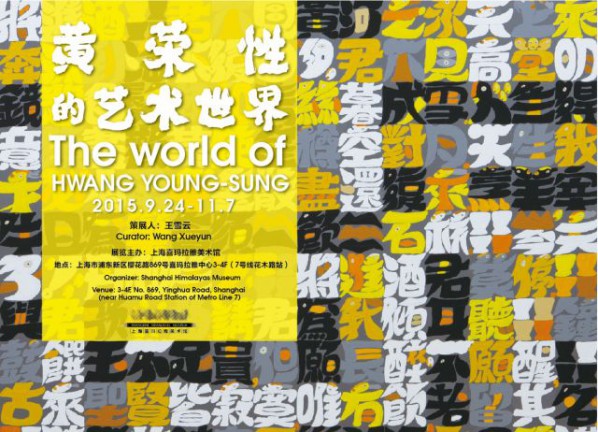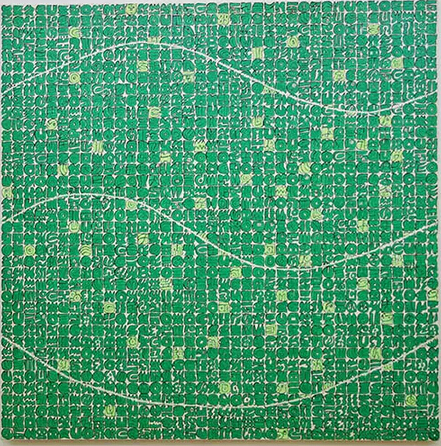
Hwang Young-Sung was born in the early 1940s in Korea and, consequently, suffered through part of the Japanese occupation and the entire Korean War – during which he became an orphan. He was born in Gwangju, in the province that engendered South Korea’s Nobel Peace Prize winning president Kim Dae-Jung, who seemed to embody that region’s spirit of strength, democracy and independence. Indeed, Gwangju was where the military dictator Chun Doo-Hwon massacred student protesters on May 18, 1980 – a protest Hwang participated in. He suffered through the dark days of occupation, war and extreme poverty (after the Korean War South Korea was one of the poorest nations on the planet) and survived through the days of brutal dictators to see a more democratic government in his homeland. He is currently the Director of the Gwangju Museum of Art and Emeritus Professor of Art at Chosun Unversity. Although admirably committed to his people and country, his work transcends any type of regional classification and embodies international influences from various eras.

Art historian Young Woo Lee has written about Hwang’s “candy-colors” as holding a semiotic system that alludes to the convergence of commercial pop and traditional ceremonial designs, as seen at weddings, funerals, birthdays, anniversaries, and on numerous holiday occasions. But candy-colors are not always present in Hwang’s work. He refuses to become a predictable painter. He lets go of color and retreats into stark black-and-white grids, as in another variation of “Family Story” from 2000. This single-panel, large canvas is more “conceptual” in its point-blank appearance, perhaps because of the reductive evenness by which the pictographic signs appear as a kind of abbreviated language system, in much the same way that hangul—the phonetic system of ideographs in Korea—appears abbreviated. One sees abstracted signs representing peasant life, including oxen, magpies, ducks, tigers, snakes, lightening bolts, hibiscus flowers, fish, mountain roots and bulbs, window frames, and the concentric circles that are prevalent in the designs found on village houses. Hwang was also influenced by the 500 statues of Budddha at Jeungshim Temple, in which each statue is a variation of the same image, thereby revealing “the myriad aspects of one united being.” This is not only close to Buddhism, but also important to the Neo-Confucian ethic that became dominant in Korea at the beginning of the Chosen Dynasty in 1392 A.D.

The diversity of images that Hwang Young Sung paints within his pictographic lexicon is truly extraordinary. In yet another segment of “Family Story” (2004), a large horizontal canvas is divided into 578 grid sections. The accentuation of a yellow hue dispersed within the black-and-white contours of the pictographic signs suggests a random system in which images are repeated to create a variety of syntax within the overall structure of the painting. In addition to the grid units on canvas that run through the “Family Story” series, Hwang experiments with other materials as well, including relief surfaces made of silicon, metal repousse, and stainless steel balls that resemble Christmas ornaments. In each case, Hwang subscribes to the notion of family signs and symbols, the elements that bind the larger units of the indigenous Korean household together. From a westernized point of view, one can talk about “family resemblances” in Hwang’s paintings in reference to early linguistic theory. However, in Hwang’s case, the resemblances between the signs come as much from sentiment as theory—this intuitive connection has a certain logic, but the system is not the point of the work. The system does not attempt to define itself as a tautology, but allows the content of the signs to intermingle syntactically in order to discover new meanings that are fully contingent upon their relationship to Korean history and culture.
Excerpts from Hwang Young Sung: Painter from GwangJu by Robert C. Morgan published on THE BROOKLYN RAIL.
About the exhibition
The World of Hwang Young-sungOrganizer: Shanghai Himalayas Museum
Dates: September 24 –November 7, 2015
Opening Reception: 17:00, October 18, 2015
Venue: Shanghai Himalayas Museum (Address 3F, A District, NO. 869 YingHua Road, Pudong district, Shanghai)
Curator: Wang Xueyun
Courtesy of the artist and Shanghai Himalayas Museum, for further information please visit www.himalayasart.cn.




























